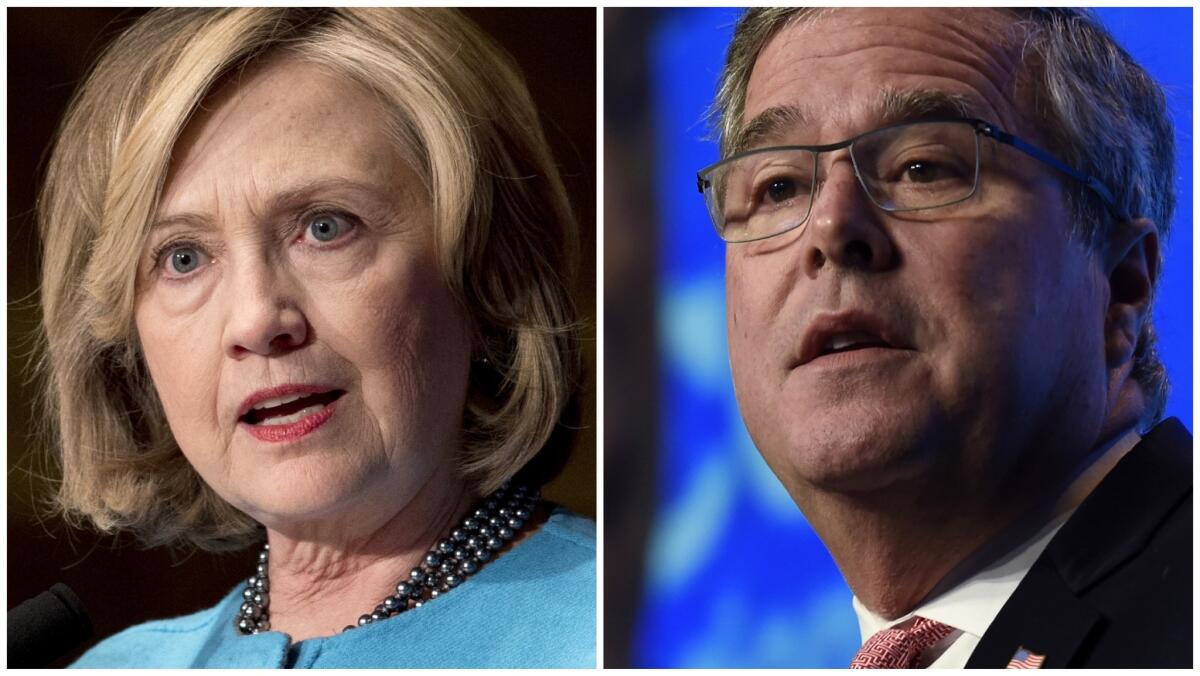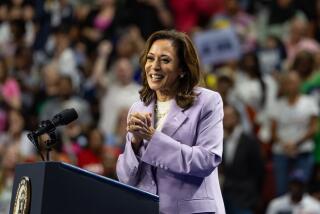Column: The invisible 2016 primary...revealed

This early stretch of presidential campaigns used to be known as the invisible primary. The action — would-be candidates drawing up strategies, courting donors and recruiting aides — occurred beyond the sight of ordinary voters.
Only it’s not invisible anymore. The sheer cost of winning a nomination — Mitt Romney spent more than $105 million two years ago — means serious candidates need to start early, well before they formally declare their intentions.
Just as in the business world, there’s an advantage that goes to the “first mover,” the first credible entrant in any competition. And by that standard, we already have two winners of the no-longer-invisible primary: Hillary Rodham Clinton and Jeb Bush.
The case for Clinton is straightforward. Without declaring, she’s established a forbidding lead in the polls, with more than 60% of Democrats saying she’s their choice.
“Her position is as strong as any we’ve ever seen for a candidate who isn’t already an incumbent president,” said Tad Devine, an advisor to Sen. Bernie Sanders of Vermont, one of Clinton’s potential challengers. “She’s in a much stronger position than she was in 2008.”
So Clinton has opted for a classic front-runner’s strategy: She is delaying a formal announcement, making the campaign shorter — a welcome idea for voters, perhaps, but not for challengers who hope to whittle down her lead.
The landscape in the Republican Party is far more complicated. With at least 12 potential candidates, no one qualifies as a front-runner — not even Bush, who drew the support of 23% of GOP voters in a CNN poll released last month (but considerably less in other polls).
Still, Bush has grabbed the first-mover role: He’s “exploring” the possibility of becoming a candidate (and, as is often noted, no politician explores that question without discovering that the answer is yes).
Then on Tuesday, Bush launched, in English and Spanish, a new political action committee that will allow him to raise money and pay a staff, purportedly to support other candidates and causes. The not-quite-candidate’s next step: releasing an e-book about his tenure as governor of Florida, designed to remind Republicans that he was once considered the most conservative politician in his family.
And he’s announced an audacious strategy: He says he’s going to stick to his long-held positions in favor of immigration reform and Common Core educational standards, whether tea party conservatives like it or not. In a television interview last month, he said he was determined not to make the same mistakes as Romney. “Mitt … got sucked into other peoples’ agendas [in the GOP primaries], and I think it hurt him,” Bush said.
“Bush’s moves have jolted the race; it’s been pretty clever,” said Republican strategist Scott Reed, who managed Bob Dole’s 1996 presidential campaign. “Everybody else now has to react to him.”
That doesn’t guarantee Bush an easy road to the GOP nomination, of course. More-conservative Republicans, tea party and otherwise, abhor the idea of sending a third Bush to the White House.
“We’re looking for a full-range conservative, and that’s not Jeb Bush,” Bob Vander Plaats, a social conservative activist in the early-caucus state of Iowa, told me this week. “I think his candidacy is mostly a Washington fantasy, confined to the 202 area code.”
Think of the Republican nominating process as two contests, not one. The first campaign, the one Bush has already kick-started, is for the votes of the establishment conservatives who have dominated most GOP primaries in the past. The competition in that race may include New Jersey Gov. Chris Christie and Ohio Gov. John Kasich.
The second campaign is for the votes of conservative insurgents, like Vander Plaats and libertarian supporters of Sen. Rand Paul (R-Ky.). That race is already underway, too: On Jan. 24, Rep. Steve King (R-Iowa) and the conservative group Citizens United are holding a Freedom Summit in Des Moines, with such potential candidates as former Ark. Gov. Mike Huckabee and Sen. Ted Cruz (R-Texas). (Bush was invited but said he couldn’t attend because of a schedule conflict.)
And there are more who may run: Rep. Paul D. Ryan (R-Wis.), Sen. Marco Rubio (R-Fla.), Wisconsin Gov. Scott Walker and Louisiana Gov. Bobby Jindal.
“There are a lot of high-quality names on those lists,” noted former Rep. Vin Weber (R-Minn.), a GOP elder. “That’s why this thing is so wide open. We sometimes forget the basics: A lot of how this comes out will depend on how they perform on the trail.”
But the lesson of the invisible primary so far is an old one: In running for president, experience counts. It’s no accident that candidates named Clinton and Bush are on top so far. There’s an irony, of course, in that, at a time when most voters yearn for change (or at least tell pollsters the country is on the wrong track), they’re getting dynastic continuity.
Can Clinton and Bush hold onto their advantages and turn into candidates of change? That’s what the campaign’s next stage is about. The invisible primary is only the first test, not the last.
doyle.mcmanus@latimes.comTwitter: @DoyleMcManus
More to Read
A cure for the common opinion
Get thought-provoking perspectives with our weekly newsletter.
You may occasionally receive promotional content from the Los Angeles Times.











